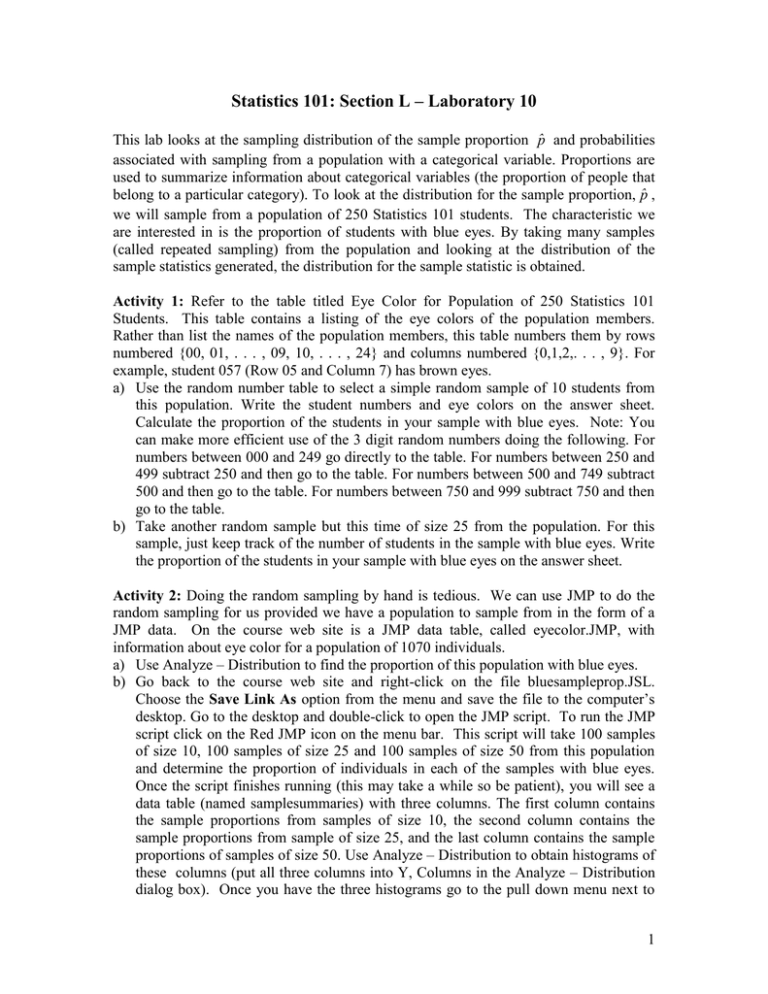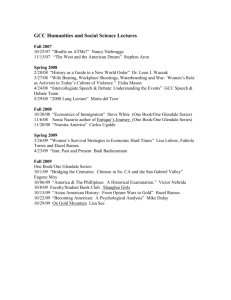Statistics 101: Section L – Laboratory 10
advertisement

Statistics 101: Section L – Laboratory 10
This lab looks at the sampling distribution of the sample proportion p̂ and probabilities
associated with sampling from a population with a categorical variable. Proportions are
used to summarize information about categorical variables (the proportion of people that
belong to a particular category). To look at the distribution for the sample proportion, p̂ ,
we will sample from a population of 250 Statistics 101 students. The characteristic we
are interested in is the proportion of students with blue eyes. By taking many samples
(called repeated sampling) from the population and looking at the distribution of the
sample statistics generated, the distribution for the sample statistic is obtained.
Activity 1: Refer to the table titled Eye Color for Population of 250 Statistics 101
Students. This table contains a listing of the eye colors of the population members.
Rather than list the names of the population members, this table numbers them by rows
numbered {00, 01, . . . , 09, 10, . . . , 24} and columns numbered {0,1,2,. . . , 9}. For
example, student 057 (Row 05 and Column 7) has brown eyes.
a) Use the random number table to select a simple random sample of 10 students from
this population. Write the student numbers and eye colors on the answer sheet.
Calculate the proportion of the students in your sample with blue eyes. Note: You
can make more efficient use of the 3 digit random numbers doing the following. For
numbers between 000 and 249 go directly to the table. For numbers between 250 and
499 subtract 250 and then go to the table. For numbers between 500 and 749 subtract
500 and then go to the table. For numbers between 750 and 999 subtract 750 and then
go to the table.
b) Take another random sample but this time of size 25 from the population. For this
sample, just keep track of the number of students in the sample with blue eyes. Write
the proportion of the students in your sample with blue eyes on the answer sheet.
Activity 2: Doing the random sampling by hand is tedious. We can use JMP to do the
random sampling for us provided we have a population to sample from in the form of a
JMP data. On the course web site is a JMP data table, called eyecolor.JMP, with
information about eye color for a population of 1070 individuals.
a) Use Analyze – Distribution to find the proportion of this population with blue eyes.
b) Go back to the course web site and right-click on the file bluesampleprop.JSL.
Choose the Save Link As option from the menu and save the file to the computer’s
desktop. Go to the desktop and double-click to open the JMP script. To run the JMP
script click on the Red JMP icon on the menu bar. This script will take 100 samples
of size 10, 100 samples of size 25 and 100 samples of size 50 from this population
and determine the proportion of individuals in each of the samples with blue eyes.
Once the script finishes running (this may take a while so be patient), you will see a
data table (named samplesummaries) with three columns. The first column contains
the sample proportions from samples of size 10, the second column contains the
sample proportions from sample of size 25, and the last column contains the sample
proportions of samples of size 50. Use Analyze – Distribution to obtain histograms of
these columns (put all three columns into Y, Columns in the Analyze – Distribution
dialog box). Once you have the three histograms go to the pull down menu next to
1
c)
d)
e)
f)
Distributions in the output and select Uniform Scaling. Use this information to
answer the following questions. Turn in your JMP output.
What are the mean values of the sample proportions for the three sample sizes? What
values should each of these means be close to? Why?
What are the standard deviation values of the sample proportions for the three sample
sizes? What values should each of these standard deviations be close to? Why?
What is the shape of the histogram of the sample proportion values for each of the
three sample sizes? Are there any differences in the shapes as the sample size
increases?
Add a normal quantile plot to each distribution output. Describe what you see in the
normal quantile plot for each sample size. Could the normal distribution be used to
model the distribution of the sample proportions for any of the three sample sizes? If
so, which ones.
Activity 3. In the first activity in lab this week you looked at selecting a random sample
of 10 from the population of 250 students and recording the proportion of students in
your sample with blue eyes. In this exercise we will look at how to use probability to see
how likely it is to get each of the possible values of the sample proportion, p̂ . Our
population has 31.2% blue eyed people and 68.8% of people with non-blue eyes. One
probability rule is that for independent trials;
Prob(A and B) = Prob(A)*Prob(B)
Note that this expands to any number of independent trials;
Prob(A and B and C and D) = Prob(A)*Prob(B)*Prob(C)*Prob(D)
a) In a random sample of 10, in order to get a value of p̂ = 0 you have to see none of the
10 people with blue eyes. That means that all 10 of the people chosen would have to
have non-blue eyes. Write a probability expression for the event that none of the 10
people have blue eyes and compute the probability.
b) In a random sample of 10, in order to get a value of p̂ = 0.1 you have to see exactly
one person with blue eyes. One way to do this is for the first person selected to have
blue eyes and the remaining nine people to have non-blue eyes. Write a probability
expression for this event and compute the probability.
c) Of course the event described in b. is not the only way to have exactly one person in a
sample of 10 have blue eyes. Name another way we could get a random sample with
p̂ = 0.1. What is the probability associated with this new event.
d) How many different ways can you get a random sample with exactly one person with
blue eyes?
e) Using b), c) and d), what is the probability that p̂ = 0.1 for a random sample of 10
people from the population with 31.2% blue eyed people?
f) What you are calculating are binomial probabilities. This is something JMP does
very easily. Go to JMP and create a new data table with three columns. Label the
first column # Blue, the second column p-hat, and the third column Probability. In
2
the first column put the numbers from 0 to 10 (you will have 11 rows). For the
second column use the Cols – Formula and enter the formula # Blue divided by 10.
For the third column use the Cols – Formula – Discrete Probability – Binomial
Probability and enter 0.312 for p, 10 for n, and click on the # Blue column for k. The
formula should look like:
Binomial Probability(0.312,10,# Blue)
g) What is the probability that p̂ = 0? What is the probability that p̂ = 0.1?
h) In order to create a distribution for the values of p̂ add another column to your JMP
table labeled Frequency. Use Cols – Formula – Probability*100,000,000 to fill this
column. Use Analyze – Distribution with p-hat in Y, Columns and Frequency in
Freq and Click on OK. For your JMP output, go to Histogram Options (red pull
down menu next to p-hat) and de-select Vertical. Also select a Prob axis. Right click
on the horizontal axis of the histogram and select Axis Settings. Make the Minimum
0, the Maximum 1, and the Increment 0.1. Use the JMP output to answer the
following questions. Turn in the JMP output.
Describe the shape of the distribution.
Compare the mean to the median. What does this comparison tell you about the
shape of the distribution?
What is the mean of the distribution? How does this relate to the proportion of
people with blue eyes in the population?
What is the standard deviation of the distribution? How does this relate to the
proportion of people with blue eyes in the population?
i) Repeat parts of f), g) and h) to construct the probability distribution for p̂ with n=25
instead of 10. You will have to create a new data table. Be careful to correctly
calculate the value of p̂ (remember that it should go from 0 to 1). Describe the
shape, center and spread and relate the center and spread to the proportion of people
in the population with blue eyes.
3
Eye Color for Population of 250 Statistics 101 Students
00
01
02
03
04
05
06
07
08
09
10
11
12
13
14
15
16
17
18
19
20
21
22
23
24
0
blue
hazel
blue
green
brown
brown
green
green
brown
blue
blue
brown
blue
blue
brown
brown
green
green
green
brown
green
green
green
brown
blue
1
brown
green
brown
brown
blue
brown
blue
hazel
hazel
green
brown
blue
blue
brown
hazel
brown
hazel
green
green
hazel
brown
blue
blue
blue
brown
2
blue
blue
blue
brown
other
brown
hazel
blue
brown
blue
brown
blue
hazel
hazel
blue
hazel
blue
other
blue
blue
green
brown
blue
blue
blue
3
brown
hazel
brown
brown
blue
blue
brown
hazel
blue
green
hazel
blue
blue
brown
hazel
hazel
green
brown
blue
blue
green
green
blue
brown
brown
4
green
brown
hazel
green
blue
blue
green
brown
blue
brown
blue
other
hazel
blue
hazel
green
brown
green
blue
hazel
brown
other
green
brown
green
5
blue
blue
green
brown
hazel
brown
green
green
blue
other
brown
green
brown
hazel
blue
brown
brown
brown
brown
blue
blue
blue
brown
hazel
green
6
brown
brown
brown
brown
brown
blue
blue
green
brown
brown
brown
blue
other
brown
brown
brown
hazel
brown
green
brown
other
blue
green
blue
blue
7
green
brown
brown
green
hazel
brown
blue
blue
brown
blue
blue
hazel
blue
blue
blue
brown
blue
green
hazel
brown
blue
hazel
blue
brown
hazel
8
green
brown
green
hazel
green
blue
blue
brown
hazel
blue
green
green
green
green
blue
brown
blue
brown
brown
green
hazel
brown
hazel
brown
blue
9
brown
blue
green
green
brown
blue
blue
green
brown
brown
brown
brown
blue
blue
brown
blue
blue
brown
green
green
blue
hazel
brown
brown
brown
4
Stat 101 L: Laboratory 10 – Answer Sheet
Names: _________________________
_________________________
_________________________
_________________________
Activity 1:
a)
Student Number
Eye Color
Student Number
Eye Color
n 10, p̂
b)
n 25, p̂
Activity 2:
a) Value of p?
b)
c)
Sample size
n = 10
Mean
Close to?
n = 25
n = 50
d)
Sample size
n = 10
Standard deviation
Close to?
n = 25
n = 50
5
e)
Sample size
n = 10
Shape of histogram
Changes in shape?
Normal quantile plot
Normal?
n = 25
n = 50
f)
Sample size
n = 10
n = 25
n = 50
Activity 3:
a) P(no one with blue eyes in sample of 10) =
b) P(first person with blue eyes and 9 other people with non blue eyes in sample of 10) =
c) Another way to get one person with blue eyes and probability associated with that
event.
d) Number of ways to get exactly one person with blue eyes in a sample of 10?
6
e)
f)
g)
P( p̂ = 0.1) =
P( p̂ = 0) =
P( p̂ = 0.1) =
h) Distribution of p̂ when n = 10.
Describe the shape of the distribution.
Compare the mean to the median. What does this comparison tell you about the shape
of the distribution?
What is the mean of the distribution? How does this relate to the proportion of people
with blue eyes in the population?
What is the standard deviation of the distribution? How does this relate to the
proportion of people with blue eyes in the population?
i)
P( p̂ = 0) =
P( p̂ = 0.1) =
Distribution of p̂ when n = 25.
Describe the shape of the distribution.
Compare the mean to the median. What does this comparison tell you about the shape
of the distribution?
What is the mean of the distribution? How does this relate to the proportion of people
with blue eyes in the population?
What is the standard deviation of the distribution? How does this relate to the
proportion of people with blue eyes in the population?
7






